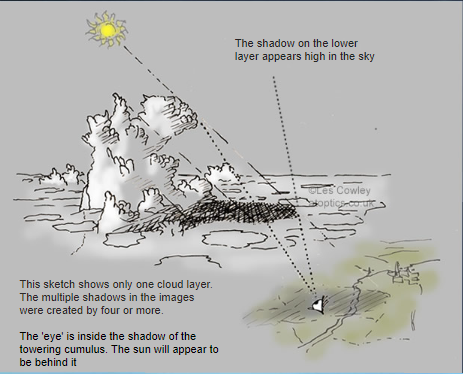Cloud shadows and colours - OPOD
Cloud Shadows and Colors: A Spectacular Atmospheric Phenomenon
Cloud shadows and colors are captivating atmospheric optics phenomena that can create stunning visual displays in the sky. While we often think of clouds as being white or gray, they actually contain a wide range of hues and shades. In this article, we will explore the mesmerizing world of cloud shadows and colors, uncovering the science behind these phenomena and the factors that contribute to their visual appearance.
The Illusion of Upward Shadows
One remarkable aspect of cloud shadows is their ability to appear as if they are cast upwards into the air. This illusion can be observed when the sun is positioned behind a towering cloud, creating multiple shadows that seemingly defy gravity. These shadows are not cast on the cloud itself, but rather on multiple layers of thin cloud or haze that would otherwise appear as a slightly hazy sky. From the ground, these shadows appear higher than the actual cloud top, giving rise to the illusion.
Unveiling the Cloud Palette
Clouds are not simply white or gray; they possess a diverse palette of colors that can be a feast for the eyes. When we look at clouds, we see a combination of colors derived from various sources. These include:
- Blues from the sky
- Deep hues from the dark interior of the cloud
- Light from other clouds
- Sunlight scattered through the "silver lining"
- Colors reflected from the ground beneath
The perceived color of a cloud also depends on individual perception and the colors of nearby objects against which the cloud is seen. This interplay of colors creates a dynamic and ever-changing visual spectacle in the sky.
Painting the Sky: Cloud Colors in Art
Children often paint clouds as white or perhaps with some gray, as they are taught to do so. However, clouds offer a much broader spectrum of colors that can inspire artists and ignite their creativity. By observing and capturing the true colors of clouds, artists can add depth and vibrancy to their artwork. The blues, pinks, purples, and oranges found within clouds can evoke a range of emotions and create a sense of awe and wonder.
Capturing the Beauty: Photography and Cloud Shadows
Photographers have the unique ability to freeze moments in time and capture the ethereal beauty of cloud shadows and colors. Through skillful composition and timing, photographers can immortalize these fleeting phenomena, allowing others to experience their splendor. From amateur photographers to professionals, many have dedicated their craft to capturing the mesmerizing interplay of light, shadow, and color in the sky.
The Role of Perception in Cloud Colors
Perception plays a significant role in how we perceive the colors of clouds. The human eye's sensitivity to different wavelengths of light can vary, leading to variations in color perception among individuals. Additionally, the colors of nearby objects against which the cloud is seen can influence our perception of the cloud's color. These factors contribute to the subjective nature of cloud colors and the unique experience they provide to each observer.
A Note of Thanks
We extend our gratitude to Mark Schnackenberg, KWWL Chief Meteorologist, for alerting us to the fascinating world of cloud shadows and colors. Their contribution has helped shed light on this captivating atmospheric phenomenon and inspire further exploration.
In conclusion, cloud shadows and colors add a touch of magic to our skies. By understanding the science behind these phenomena and appreciating the intricate interplay of light, shadow, and color, we can develop a deeper appreciation for the beauty that surrounds us. Whether it's through art, photography, or simply gazing at the sky, let us embrace the ever-changing canvas that nature paints for us and marvel at the wonders of atmospheric optics.

Cloud Shadows & Rays
A dramatic sight captured by Kevin Radley near Parnell, IL. The sun is behind the towering cloud as it casts 3-5 shadows apparently upwards into the air.
Images ©Kevin Radley, shown with permission

This sketch shows only one cloud layer. The multiple shadows in the images were created by four or more.
The 'eye' is inside the shadow of the towering cumulus. The sun will appear to be behind it
.
The shadows are cast on multiple layers of thin cloud/haze that would otherwise be seen only as a slightly hazy sky. From the eye on the ground they appear higher than the cloud top - but that is an illusion.
How to paint clouds. Colours at right plucked from the cloud. Children almost always paint clouds as white or maybe with some grey - we are taught so. Whereas they contain a host of hues.
Blues from the sky, deep hues from the dark interior, light from other clouds, sunlight scattered through the 'sliver lining' and colours of the ground beneath all add to the cloud palette.
The perceived colour depends too on the eye and colours of nearby objects against which the cloud is seen.

A thank you to Mark Schnackenberg, KWWL Chief Meteorologist, for alerting OPOD.
Note: this article has been automatically converted from the old site and may not appear as intended. You can find the original article here.
Reference Atmospheric Optics
If you use any of the definitions, information, or data presented on Atmospheric Optics, please copy the link or reference below to properly credit us as the reference source. Thank you!
-
<a href="https://atoptics.co.uk/blog/cloud-shadows-and-colours-opod/">Cloud shadows and colours - OPOD</a>
-
"Cloud shadows and colours - OPOD". Atmospheric Optics. Accessed on December 25, 2024. https://atoptics.co.uk/blog/cloud-shadows-and-colours-opod/.
-
"Cloud shadows and colours - OPOD". Atmospheric Optics, https://atoptics.co.uk/blog/cloud-shadows-and-colours-opod/. Accessed 25 December, 2024
-
Cloud shadows and colours - OPOD. Atmospheric Optics. Retrieved from https://atoptics.co.uk/blog/cloud-shadows-and-colours-opod/.